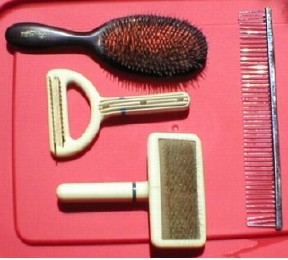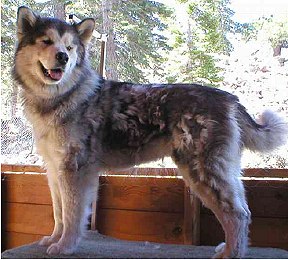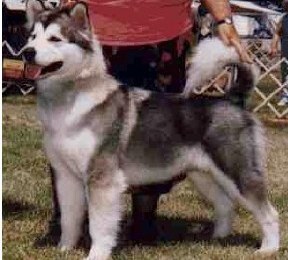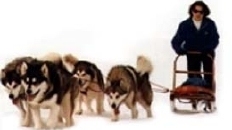The Well-Groomed Malamute

Mud Puppy Star, a Moon daugher
photo courtesy of D. Littlefield
Routine Care
Nails: trim at least once a month. With young puppies, & untrained dogs, aim for doing a few nails at a time. See where the quick is and do not cut into
it. If the nail bleeds, apply Kwik stop. You may need a partner to hold the pup. It's easier to do this after the pup has been for a walk and is tired. We
place our dogs on their sides on the floor to trim. Give the pup a treat and lots of praise.
Ears use Otis ear cleaner or an astringent solution. Ears should be cleaned at least once a month. Squirt several drops into one ear.
Massage the base. Let dog shake, then use a cotton ball to wipe away dirt. Repeat if necessary.
Teeth Clean teeth at least twice a week (more often if possible) with a gauze soaked with hydrogen peroxide or baking soda or use a toothbrush and special
toothpaste
for dogs. If your dog ever is under anesthetia schedule a cleaning at the same time. An alternative to brushing, we use rawhide chews and frozen soup bones
2-3 times a week. If you use
bones and chews make sure you remove them when the pieces are small.

Bristle Brush, Rake, Slicker, Wide-Toothed Comb
Necessary Grooming Supplies
1. Natural Bristle Brush
2. Rake
3. Soft Slicker Brush
4. Wide-tooth "Poodle" Comb
5. Nail trimmers and Kwik-stop
Other Useful Supplies
1. Mars Coat King for stripping dense coats or matted hair
2. Metro or Circuiteer blow dryer
3. Waterless/non-rinse Shampoo for quick clean-ups
4. Toothbrush & dog tooth paste
5. Shears/scissors for trimming undersides of feet
6. Portable light-weight bath tub

After her whelping her pups,
Moon goes through a major shed
Brushing & Coat Care
For regular weekly grooming sessions use the soft slicker or bristle brush. Use the comb or rake to remove undercoat or to tease apart tangles or
mats. First lightly mist the coat with water then brush in direction
of hair
growth, from head to tail, Then brush and comb in the opposite direction, layer by layer, a small portion at the time. Divide the hair with one hand, hold and
brush then comb
down to the skin. When entire body has been brushed against the grain, then brush the coat
back in place. When the dog's body is done, do the tail. First use a rake and slicker brush. Then a comb. This sensitive area often mats so be gentle.
Geriatric dogs and young pups are best groomed in multiple short sessions one section or side at a time. Old dogs may be more comfortable groomed on
the floor.
Don't forget to brush the underside and legs. As you groom your dog, spend a few minutes running your fingers gently through the coat. Feel for any lumps. Look for foxtails and sores or inflammed areas. Regular grooming is especially important for older dogs

Towels, shampoo brush, large sponge and basin
Preparing for a Bath
During major shedding, it's best if
you take the time to thoroughly comb and brush the dead hair out BEFORE bathing otherwise it will mat. Use the rake first, then the poodle comb, then the slicker
to remove any remaining loose
undercoat. Keep a large waste basket handy as you won't believe how quickly it will fill up.
Lay the dog on his side. Start with the head and neck and remove collar. Pay particular attention to any mats under the collar.
Imagine a line along the spine dividing the dog in half. Work down from the neck, flanks, breeches.
Remember to part the hair, layer by layer with one hand, and then brush and comb with the other.
When one half/one side of the dog is finished, turn him over and start again at the head and neck, working toward the tail
Then bathe the dog in medium-hot water and blow dry, combing out the remaining dead coat. Use a mild shampoo - anything you have at home is fine if you add some distilled vinegar and glycerin to adjust the PH levels.
Always use warm water. Place a non-skid rubber mat in
the tub if slippery.
Before you begin, assemble supplies: several towels, brush, shampoo, or sponge.
Dilute shampoo in a basin or bucket. For show grooming we like use Traleigh or Ikaria shampoo.

Moon in the portable Booster Bathtub
Bath Time
Thoroughly soak the dog (do the head last) Fold ears down and
cover eyes with your hand when you rinse the dog's face. Once the dog is soaked, apply diluted shampoo with sponge. Use a brush
to work the lather in. Work both sides, tail, legs and on underside and feet. On face, scrub with small brush (nail brush) or wash cloth.
Rinse well. Keep rinsing till water drains clear. If dog is very dirty, the first lathering should be done with dish detergent; then a second and third
lathering can be done
with the mild shampoo. Pay particular attention to the chest, collar and belly areas as these are usually the most soiled and the easiest to miss! In heavily
soiled areas, add
undiluted shampoo directly to sponge or brush and hit these areas again. For skin problems, or problem areas, (hot spots etc.,) use an iodine based or medicated
shampoo. Once the dog is
thoroughly cleaned, and rinsed, a coat conditioner may be applied to tail and breeches to aid in detangling. Rinse thoroughly.
Allow dog to shake off in tub. Then squeeze dry with several towels. If the dog is not being shown, let him air dry for a couple of hours--either on a deck if it's sunny or in a crate
padded with bedding; then blow
dry.

A totally naked Moon takes a 5 pt major
and finishes her championship
Show Grooming
Our dogs are presented naturally in the show ring with no products left in the coat. Shasta won multiple Best in Shows, handled by Ann Storniolo who groomed
only with water--no texturizers, cornstarch or added sprays. Here's how we do it. The morning
of the show, wash whites (feet) with a mild shampoo and towel dry. Lay the dog on his side and line comb from head to tail. Mist the entire coat with water
and use the blower to set the coat.
Trim nails and feet the day before. Cut any scraggly long hair between the pads on the bottom of the foot. Cut fur around dogs foot, trimming against
the table surface to trace a neat outline of the foot.
Removing whiskers is optional. Use small blunt scissors or nail clippers. And that's it. A malamute in good condition with substantial bone and large feet does not need to be moussed, powdered and sculpted to create an illusion of coat or bone. Moon's wins just weeks
after she weaned her pups, demonstrates that a sound dog can win totally out-of-coat.
Other good shampoos: Traleigh | JB Almond |


